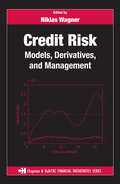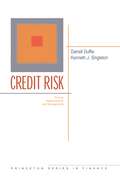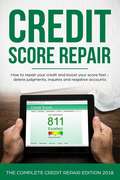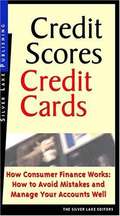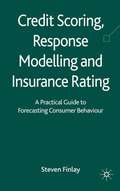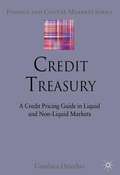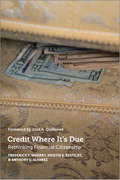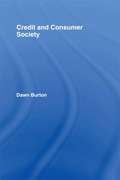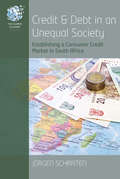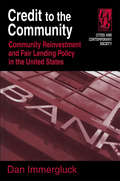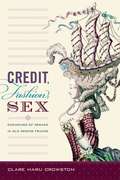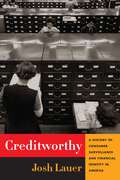- Table View
- List View
Credit Risk: Models, Derivatives, and Management (Chapman and Hall/CRC Financial Mathematics Series)
by Niklas WagnerFeaturing contributions from leading international academics and practitioners, Credit Risk: Models, Derivatives, and Management illustrates how a risk management system can be implemented through an understanding of portfolio credit risks, a set of suitable models, and the derivation of reliable empirical results.Divided into six sectio
Credit Risk: Pricing, Measurement, and Management (Princeton Series in Finance)
by Darrell Duffie Kenneth J. SingletonIn this book, two of America's leading economists provide the first integrated treatment of the conceptual, practical, and empirical foundations for credit risk pricing and risk measurement. Masterfully applying theory to practice, Darrell Duffie and Kenneth Singleton model credit risk for the purpose of measuring portfolio risk and pricing defaultable bonds, credit derivatives, and other securities exposed to credit risk. The methodological rigor, scope, and sophistication of their state-of-the-art account is unparalleled, and its singularly in-depth treatment of pricing and credit derivatives further illuminates a problem that has drawn much attention in an era when financial institutions the world over are revising their credit management strategies. Duffie and Singleton offer critical assessments of alternative approaches to credit-risk modeling, while highlighting the strengths and weaknesses of current practice. Their approach blends in-depth discussions of the conceptual foundations of modeling with extensive analyses of the empirical properties of such credit-related time series as default probabilities, recoveries, ratings transitions, and yield spreads. Both the "structura" and "reduced-form" approaches to pricing defaultable securities are presented, and their comparative fits to historical data are assessed. The authors also provide a comprehensive treatment of the pricing of credit derivatives, including credit swaps, collateralized debt obligations, credit guarantees, lines of credit, and spread options. Not least, they describe certain enhancements to current pricing and management practices that, they argue, will better position financial institutions for future changes in the financial markets. Credit Risk is an indispensable resource for risk managers, traders or regulators dealing with financial products with a significant credit risk component, as well as for academic researchers and students.
Credit Score Repair: How to Repair your Credit and Boost your Score fast - Delete Judgements, Inquiries and Negative Acounts
by Dana LeeRoughly 30 percent of all Americans are dealing with a poor credit score and more are falling into the trap of bad credit on a daily basis. When you are at the bottom of a debt-shaped hole it can appear as though the deck is stacked against you and that you have no way of climbing your way out. <p><p> It doesn’t matter what type of debt you have accrued, the amount or how recently it has happened, there are numerous different ways of removing it from your credit report ASAP, all of which are discussed in detail inside including step by step instructions and even sample letters when applicable. You will find ways for dealing with credit card debt, late payments, liens, and judgments, even foreclosures in the quickest and most effective means possible. While creditors will lead you to believe otherwise, there are actually a wide variety of options available to those who are simply aware of their rights and are willing to fight to work out the best deals for themselves as possible, all of which are discussed in detail inside.
Credit Scores, Credit Cards: How to Avoid Mistakes and How to Manage Your Accounts Well
by Editors of Silver Lake PublishingProvides timely and valuable information on how consumer credit works in the U.S. and how to improve your credit.
Credit Scoring Secrets: How To Raise Your Credit Score 100 Points In 100 Days
by James L. ParisThe book is based on years of working with individual clients with credit situations as difficult as recent bankruptcies, foreclosures, and even IRS tax liens. Includes letters that can be used to dispute inaccurate information from a credit bureau report. Step by step information on what you need to do if you are currently attempting to get approved for a credit card, auto loan, or mortgage. Includes sources of no qualifying credit accounts that can be used to rebuild credit.
Credit Scoring, Response Modeling, and Insurance Rating
by Steven FinlayWithin the financial services industry today, most decisions on how to deal with consumers are made automatically by computerized decision making systems. At the heart of these systems lie mathematically derived forecasting models. These use information about people and their past behaviour, to predict how people are likely to behave in the future. For example, who is likely to repay a loan, who will respond to a mail shot and the likelihood that someone will claim on their household insurance policy. Decisions about how to treat people are then made on the basis of the predictions calculated by the system. This book provides a step-by-step guide to how the forecasting models used by the worlds leading financial institutions are developed and deployed. It covers all stages involved in the construction of such a model, including project management, data collection, sampling, data pre-processing, model construction, validation, implementation and post-implementation monitoring of the model's performance.
Credit Scoring, Response Modelling and Insurance Rating
by Steven FinlayEvery year, financial services organizations make billions of dollars worth of decisions using automated systems. For example, who to give a credit card to and the premium someone should pay for their home insurance. This book explains how the forecasting models, that lie at the heart of these systems, are developed and deployed.
Credit Treasury
by Gianluca OricchioThis book presents the state-of-the-art with respect to credit risk evaluation and pricing within the contemporary global banking and financial system. It focuses on credit pricing in illiquid, liquid and hybrid markets. No one with any connection to the credit management business will be able to do without it.
Credit Where It's Due: Rethinking Financial Citizenship
by Frederick F. Wherry Kristin S. Seefeldt Anthony S. Alvarez Jose QuinonezAn estimated 45 million adults in the U.S. lack a credit score at time when credit invisibility can reduce one’s ability to rent a home, find employment, or secure a mortgage or loan. As a result, individuals without credit—who are disproportionately African American and Latino—often lead separate and unequal financial lives. Yet, as sociologists and public policy experts Frederick Wherry, Kristin Seefeldt, and Anthony Alvarez argue, many people who are not recognized within the financial system engage in behaviors that indicate their credit worthiness. How might institutions acknowledge these practices and help these people emerge from the financial shadows? In Credit Where It’s Due, the authors evaluate an innovative model of credit-building and advocate for a new understanding of financial citizenship, or participation in a financial system that fosters social belonging, dignity, and respect. Wherry, Seefeldt, and Alvarez tell the story of the Mission Asset Fund, a San Francisco-based organization that assists mostly low- and moderate-income people of color with building credit. The Mission Asset Fund facilitates zero-interest lending circles, which have been practiced by generations of immigrants, but have gone largely unrecognized by mainstream financial institutions. Participants decide how the circles are run and how they will use their loans, and the organization reports their clients’ lending activity to credit bureaus. As the authors show, this system not only helps clients build credit, but also allows them to manage debt with dignity, have some say in the creation of financial products, and reaffirm their sense of social membership. The authors delve into the history of racial wealth inequality in the U.S. to show that for many black and Latino households, credit invisibility is not simply a matter of individual choices or inadequate financial education. Rather, financial marginalization is the result of historical policies that enabled predatory lending, discriminatory banking and housing practices, and the rollback of regulatory protections for first-time homeowners. To rectify these inequalities, the authors propose common sense regulations to protect consumers from abuse alongside new initiatives that provide seed capital for every child, create affordable short-term loans, and ensure that financial institutions treat low- and moderate-income clients with equal respect. By situating the successes of the Mission Asset Fund in the larger history of credit and debt, Credit Where It’s Due shows how to prioritize financial citizenship for all.
Credit and Blame at Work: How Better Assessment Can Improve Individual, Team and Organizational Success
by Ben DattnerPreviously published as The Blame Game, this acclaimed guide by a leading workplace expert offers essential advice about how to succeed at work by avoiding the pitfalls of pervasive credit-grabbing and finger-pointing.Credit and Blame at Work, praised by bestselling management expert Robert Sutton as “a modern management classic; one of the most well-crafted business books I have ever read,” psychologist and workplace consultant Ben Dattner reveals that at the root of the worst problems at work is the skewed allocation of credit and blame. It’s human nature to resort to blaming others, as well as to take more credit for successes than we should. Many managers also foster a “blame or be blamed” culture that can turn a workplace into a smoldering battlefield and upend your career. Individuals are scapegoated, teams fall apart, projects get derailed, and people become disengaged because fear and resentment take hold. But Dattner shows that we can learn to understand the dynamics of this bad behavior so that we can inoculate ourselves against it. In lively prose, Dattner tells a host of true stories from individuals and teams he’s worked with, identifying the eleven personality types who are especially prone to credit and blame problems and introducing simple methods for dealing with each of them. The rich insights and powerful practical advice Dattner offers allow readers to master the vital skills necessary for rising above the temptations of the blame game, defusing the tensions, and achieving greater success.
Credit and Collateral (Routledge International Studies in Money and Banking)
by Vania SenaCollateral - generally defined as an asset used to provide security for a lender's loan - is an important feature of credit contracts and all the available evidence suggests that its use is getting more pervasive. This informative book builds upon recent research into this topic. Sena analyses three case-studies that revolve around the impact that financial constraints have on economic outcomes. In the first case-study, the relationship between firms’ technical efficiency and increasing financial pressure is explored. The author then goes on to show, in the second case study, that under specific circumstances, increasing financial pressure and increasing product market competition can jointly have a positive impact on firms’ technical efficiency, while not being true for all types of firms. In the third case, she analyses the impact that finance constraints have on women’s start-ups. Unique and revealing, this is the first book to deal so extensively with the topic of collateral, and as such, is a valuable reference to postgraduates and professionals in the fields of macroeconomics, monetary and business economics.
Credit and Consumer Society
by Dawn BurtonThe language of credit and debt is almost ubiquitous in daily life. In advanced modern societies, financial institutions and other organizations have become increasingly active in lending money to consumers, and consumers apparently more than willing to take advantage. This groundbreaking new book offers an analysis of this important phenomenon, arguing that we have entered an era in which credit and debt are sanctioned, delivered and collected through new cultural and economic mechanisms. Written in an accessible and straightforward style, the book takes a multi-disciplinary approach, examining consumer credit and debt in both societal and economic contexts. It explores key topics such as: the historical context of credit and debt current theories of a consumer-centred society the credit industry attempts at government regulation. Credit and Consumer Society establishes the wider analysis of consumer credit and debt as a discipline in its own right. It is important reading for students and researchers in business and management, finance, public policy and sociology, as well as for policy makers and consumer groups working directly in this field.
Credit and Debt in Eighteenth-Century England: An Economic History of Debtors’ Prisons (Perspectives in Economic and Social History)
by Alexander WakelamThroughout the eighteenth century hundreds of thousands of men and women were cast into prison for failing to pay their debts. This apparently illogical system where debtors were kept away from their places of work remained popular with creditors into the nineteenth century even as Britain witnessed industrialisation, market growth, and the increasing sophistication of commerce, as the debtors’ prisons proved surprisingly effective. Due to insufficient early modern currency, almost every exchange was reliant upon the use of credit based upon personal reputation rather than defined collateral, making the lives of traders inherently precarious as they struggled to extract payments based on little more than promises. This book shows how traders turned to debtors’ prisons to give those promises defined consequences, the system functioning as a tool of coercive contract enforcement rather than oppression of the poor. Credit and Debt demonstrates for the first time the fundamental contribution of debt imprisonment to the early modern economy and reveals how traders made use of existing institutions to alleviate the instabilities of commerce in the context of unprecedented market growth. This book will be of interest to scholars and researchers in economic history and early modern British history.
Credit and Debt in an Unequal Society: Establishing a Consumer Credit Market in South Africa (The Human Economy #7)
by Jürgen SchratenSouth Africa was one of the first countries in the Global South that established a financialized consumer credit market. This market consolidates rather than alleviates the extreme social inequality within a country. This book investigates the political reasons for adopting an allegedly self-regulating market despite its disastrous effects and identifies the colonialist ideas of property rights as a mainstay of the existing social order. The book addresses sociologists, political scientists, anthropologists and legal scholars interested in the interaction of economy and law in contemporary market societies.
Credit and Trade in Later Medieval England, 1353-1532 (Palgrave Studies in the History of Finance)
by Richard GoddardThis book challenges the notion that economic crises aremodern phenomena through its exploration of the tumultuous 'credit-crunch' ofthe later Middle Ages. It illustrates clearly how influences such as the BlackDeath, inter-European warfare, climate change and a bullion famine occasionedsevere and prolonged economic decline across fifteenth century England. Earlychapters discuss trends in lending and borrowing, and the use of credit to funddomestic trade through detailed analysis of the Statute Staple and rich primarysources. The author then adopts a broad-based geographic lens to examineprovincial credit before focusing on London's development as the commercial powerhousein late medieval business. Academics and students of modern economic change and historicfinancial revolutions alike will see that the years from 1353 to1532 encompassed immense upheaval and change, reminiscent of modern recessions. The author carefully guides the reader to see that these shifts are theprecursors of economic change in the early modern period, laying thefoundations for the financial world as we know it today.
Credit to Capabilities
by Paromita SanyalCredit to Capabilities focuses on the controversial topic of microcredit's impact on women's empowerment and, especially, on the neglected question of how microcredit transforms women's agency. Based on interviews with hundreds of economically and socially vulnerable women from peasant households, this book highlights the role of the associational mechanism - forming women into groups that are embedded in a vast network and providing the opportunity for face-to-face participation in group meetings - in improving women's capabilities. This book reveals the role of microcredit groups in fostering women's social capital, particularly their capacity of organizing collective action for public goods and for protecting women's welfare. It argues that, in the Indian context, microcredit groups are becoming increasingly important in rural civil societies. Throughout, the book maintains an analytical distinction between married women in male-headed households and women in female-headed households in discussing the potentials and the limitations of microcredit's social and economic impacts.
Credit to the Community: Community Reinvestment and Fair Lending Policy in the United States
by Dan ImmergluckThis book provides the most comprehensive examination of community reinvestment and fair lending problems and policies currently available. It outlines the history of lending discrimination and redlining in U.S. mortgage and small business lending markets, and documents the persistence of such problems today. The author explains the role that government has played in developing banking and credit markets in the United States, from the creation of Alexander Hamilton's First Bank of the United States to the ongoing support government provides through the subsidization of secondary markets and through maintenance of critical regulatory infrastructure. Immergluck takes issue with those calling for deregulation of financial services - especially in the arena of fair lending and consumer protection - and gives new voice to rationales for social contract policies such as the Community Reinvestment Act. He provides new long-term analysis of the failure of federal bank regulators to enforce the CRA, and also shows how increased community activism and media attention have led to sporadic periods of stronger CRA enforcement. Finally, he recommends a number of policy changes that are needed to modernize the nation's fair lending and community reinvestment laws and make them more relevant for the 21st century.
Credit, Fashion, Sex: Economies of Regard in Old Regime France
by Clare Haru CrowstonIn Old Regime France credit was both a central part of economic exchange and a crucial concept for explaining dynamics of influence and power in all spheres of life. Contemporaries used the term credit to describe reputation and the currency it provided in court politics, literary production, religion, and commerce. Moving beyond Pierre Bourdieu's theorization of capital, this book establishes credit as a key matrix through which French men and women perceived their world. As Clare Haru Crowston demonstrates, credit unveils the personal character of market transactions, the unequal yet reciprocal ties binding society, and the hidden mechanisms of political power.Credit economies constituted "economies of regard" in which reputation depended on embodied performances of credibility. Crowston explores the role of fashionable appearances and sexual desire in leveraging credit and reconstructs women's vigorous participation in its gray markets. The scandalous relationship between Queen Marie Antoinette and fashion merchant Rose Bertin epitomizes the vertical loyalties and deep social divides of the credit regime and its increasingly urgent political stakes.
Credit-Risk Modelling: Theoretical Foundations, Diagnostic Tools, Practical Examples, And Numerical Recipes In Python
by David Jamieson BolderThe risk of counterparty default in banking, insurance, institutional, and pension-fund portfolios is an area of ongoing and increasing importance for finance practitioners. It is, unfortunately, a topic with a high degree of technical complexity. Addressing this challenge, this book provides a comprehensive and attainable mathematical and statistical discussion of a broad range of existing default-risk models. Model description and derivation, however, is only part of the story. Through use of exhaustive practical examples and extensive code illustrations in the Python programming language, this work also explicitly shows the reader how these models are implemented. Bringing these complex approaches to life by combining the technical details with actual real-life Python code reduces the burden of model complexity and enhances accessibility to this decidedly specialized field of study. The entire work is also liberally supplemented with model-diagnostic, calibration, and parameter-estimation techniques to assist the quantitative analyst in day-to-day implementation as well as in mitigating model risk. Written by an active and experienced practitioner, it is an invaluable learning resource and reference text for financial-risk practitioners and an excellent source for advanced undergraduate and graduate students seeking to acquire knowledge of the key elements of this discipline.
CreditEase: Providing Credit and Financial Services for China's Underclass
by Paul M. Healy Nancy Hua Dai Lena G. GoldbergIn 2013 Ning Tang, who in 2006 founded CreditEase as a broker of P2P loans to unbanked individuals and small businesses in China, confronts the challenges of rapid growth and expansion in a changing regulatory environment. CreditEase needs to develop technology to manage its growth, address issues related to the company's expansion into products and services for China's growing high net worth (HNW) population, including questions about the suitability of its products and its vulnerability to bad debt losses and a potential leveling off of the growth in China's economy, and adjust to new and more intensive regulatory oversight. What should Tang do to position CreditEase so that it can continue to fulfill its mission of making financial products and services available to millions of underserved Chinese while branching out into other, potentially riskier lines of business and ensuring continuing compliance with evolving laws and regulations? Will its rapid growth be sustainable?
CreditEase: Taking Inclusive Finance Online
by Nancy Hua Dai Michael Chu John S. JiThe world's largest peer-to-peer (P2P) lender annually disbursing over a million loans totaling $10 billion, China's CreditEase, must decide whether to IPO in the NYSE its online lending platform, Yirendai, before the year-end window closes in 2015. Yirendai sought to capture its customers and make virtually instantaneous credit decisions online. CreditEase's commercial success makes funding Yirendai's growth not an issue. P2P lending in China, after explosive growth followed by notorious frauds, is increasingly controversial. On the way to becoming a global example of financial inclusion, as a result of its original business model, CreditEase also pioneered and became a leader in the wealth management industry in China, serving the country's new mass affluent and high net worth families. With so many options, how should Ning Tang, founder and CEO, chart the future strategic direction of CreditEase?
Creditor Activism in Sovereign Debt: "Vulture" Tactics or Market Backbone
by Laura Alfaro Ingrid VogelThe role of distressed debt funds, also known as "vulture funds," in sovereign debt restructuring was a hotly debated topic, especially after the success of Elliot Associates in converting an $11 million investment in Peruvian bonds worth $21 million into a $58 million cash payout from the country, representing the full face value of the bonds plus past-due interest. Highlights the problems associated with debt restructuring coordination. On the one hand, many observers derided firms such as Elliot and Dart as "vultures" or "rouge creditors" who sought to profit on sovereign debt restructurings at the expense of countries suffering economic hardship and of the majority of bondholders whose cooperation allowed the restructurings to take place. Critics believed that these holdout creditors created "collective action problems" and presented a major obstacle to successful sovereign debt restructurings. On the other hand, other observers argued that activist investors actually improved the market overall by demonstrating the enforceability of contracts. In fact, they argued that creditors faced too many hurdles in collecting against countries after receiving favorable judgments in support of claims.
Creditor Activism in Sovereign Debt: Argentina vs. Holdout Investors (B)
by Laura Alfaro Hilary White Gaurav ToshniwalSupplement
Creditworthy: A History of Consumer Surveillance and Financial Identity in America (Columbia Studies in the History of U.S. Capitalism)
by Josh LauerThe first consumer credit bureaus appeared in the 1870s and quickly amassed huge archives of deeply personal information. Today, the three leading credit bureaus are among the most powerful institutions in modern life—yet we know almost nothing about them. Experian, Equifax, and TransUnion are multi-billion-dollar corporations that track our movements, spending behavior, and financial status. This data is used to predict our riskiness as borrowers and to judge our trustworthiness and value in a broad array of contexts, from insurance and marketing to employment and housing. In Creditworthy, the first comprehensive history of this crucial American institution, Josh Lauer explores the evolution of credit reporting from its nineteenth-century origins to the rise of the modern consumer data industry. By revealing the sophistication of early credit reporting networks, Creditworthy highlights the leading role that commercial surveillance has played—ahead of state surveillance systems—in monitoring the economic lives of Americans. Lauer charts how credit reporting grew from an industry that relied on personal knowledge of consumers to one that employs sophisticated algorithms to determine a person's trustworthiness. Ultimately, Lauer argues that by converting individual reputations into brief written reports—and, later, credit ratings and credit scores—credit bureaus did something more profound: they invented the modern concept of financial identity. Creditworthy reminds us that creditworthiness is never just about economic "facts." It is fundamentally concerned with—and determines—our social standing as an honest, reliable, profit-generating person.
Cree Inc.: Introducing the LED Light Bulb
by Michael Norris John GourvilleCree, a North Carolina-based maker of light emitting diodes (LEDs), has just introduced its first consumer product - an LED light bulb. It is designed as an energy efficient replacement for the ubiquitous incandescent light bulb. But given that it is an unfamiliar technology and that it costs ten times what an incandescent bulb costs, there are questions about how best to promote adoption and what sales level might be expected.
